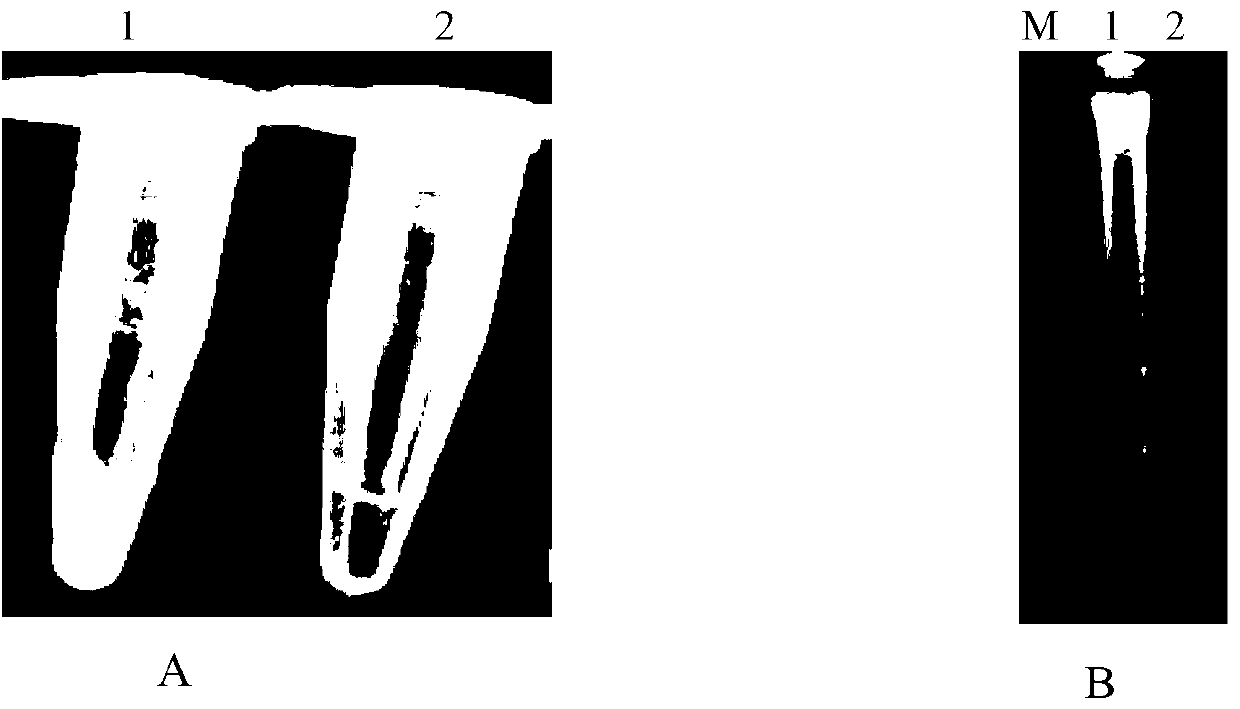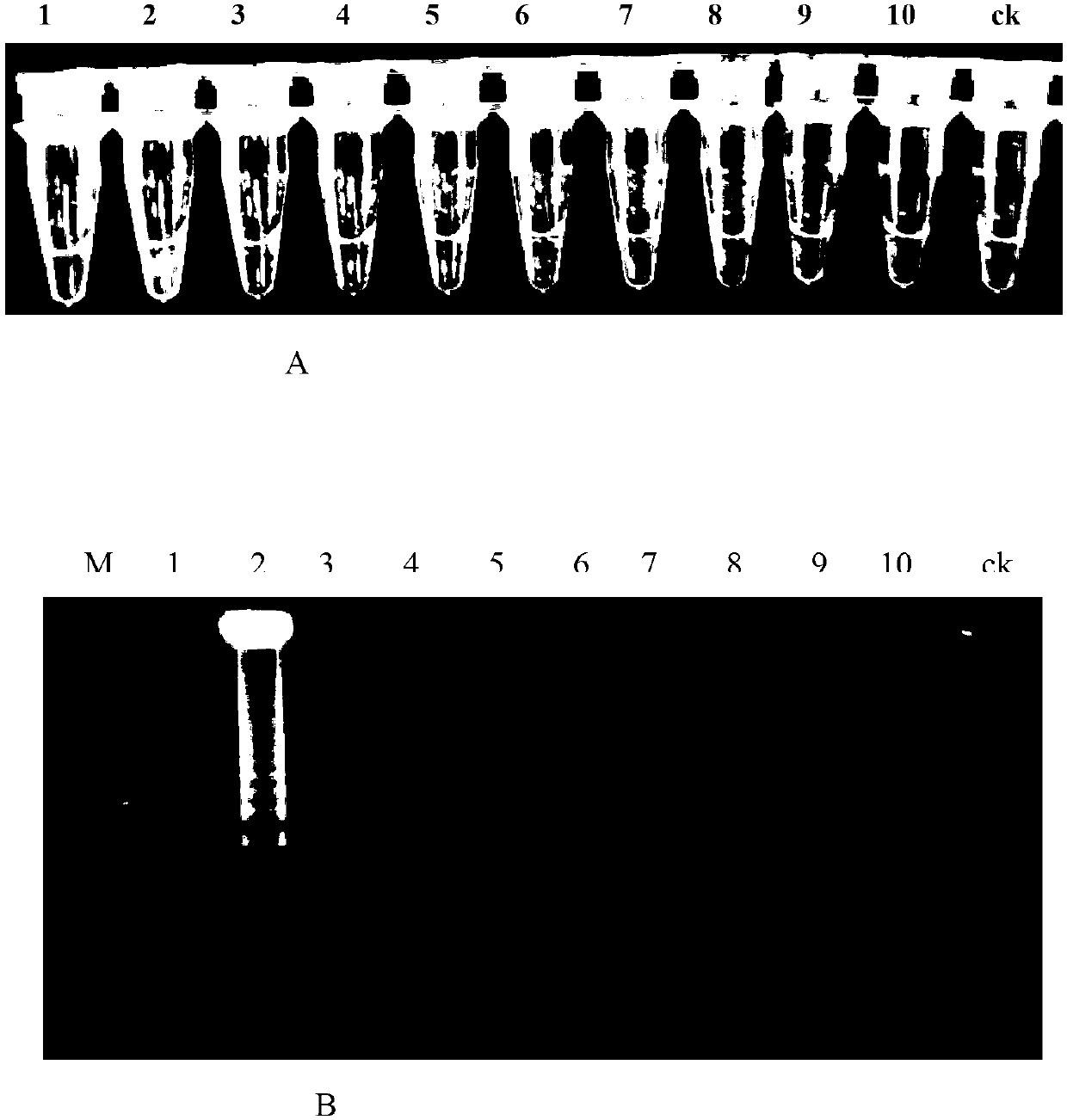LAMP rapid detection method for Heterodera filipjevi and its application
A detection method, the technology of Philips spore, is applied in the directions of biochemical equipment and methods, and the determination/inspection of microorganisms, which can solve the problems of limiting the popularization and application of PCR detection methods, and achieve the effects of short detection time, direct results and simple operation steps.
- Summary
- Abstract
- Description
- Claims
- Application Information
AI Technical Summary
Problems solved by technology
Method used
Image
Examples
Embodiment 1
[0078] Example 1 Extraction, RAPD amplification and sequence analysis of Phillips cyst nematode DNA
[0079] 1.1 Extraction of Phillips cyst nematode DNA
[0080] Pick a single Phillips cyst and place it in a medium containing 10 μl ddH 2 In a 0.2mL centrifuge tube of O, freeze with liquid nitrogen, take it out and put it on ice, turn it in the centrifuge tube with a sterile glass rod until the ice melts, break the cysts, release the eggs, add 8 μl of LB solution, 2 μl of 600 μg / ml proteinase K solution was then frozen at -80°C for 30 minutes. The centrifuge tube was taken out, incubated at 65°C for 90min, and reacted at 95°C for 10min. After treatment, the supernatant was directly used as a nematode DNA template for LAMP and PCR reactions.
[0081] 1.2 Amplification and sequence analysis of SCAR fragments of Phillips cyst nematode
[0082] SCAR marker primers OPK16-HfF2 (5`-CAGGACGAAACTCATTCAACCAA-3`) and OPK16-HfR2 (5`-AGGGCGAACAGGAGAAGATTAGA-3`) were used to amplify the ...
Embodiment 2
[0083] Example 2 Establishment of LAMP Technology Detection Method for Philip's Cyst Nematode
[0084] 2.1 LAMP primer design
[0085] According to the sequencing results of the SACR-specific fragments of Phillipe cyst nematode, the following LAMP primers were designed and screened (see figure 1 ), the primers were synthesized by Shanghai Bioengineering Technology Service Co., Ltd. The primer sequences are as follows:
[0086] ①HF11-F3: 5`-GGCAGCGATCAAAAGACT-3`;
[0087] ②HF11-B3: 5`-AAATGTGATGTTCCCAAGTG-3`;
[0088] ③HF11-BIP: 5`-GAGTCCTTTTGTTTAGCATGGGTTGGAGCCATGTTATTT TGTTGA-3`;
[0089] ④HF11-FIP: 5`-TCTTGGTGCCCAAACTTCCCGCATCTAACATTCTCAATA ATTGTC-3`;
[0090] ⑤HF11-LF: 5`-GGGGCCAAAGAATGTGTAAATCAAT-3`;
[0091] ⑥HF11-LB: 5`-TTTAGCGCCCATTTAAGCGT-3`;
[0092] 2.2 LAMP reaction system configuration:
[0093] Primer mixture: 0.2 μmol / L for outer primers HF11-F3 and HF11-B3, 1.4 μmol / L for inner primers HF11-FIP and HF11BIP, and 0.4 μmol / L for loop primers HF11-LB and HF1...
Embodiment 3
[0096] Example 3 Phillips cyst nematode LAMP specific detection
[0097] Collect cereal cyst nematodes, Phillips cyst nematodes, soybean cyst nematodes, upland rice cyst nematodes, pea cyst nematodes, barley cyst nematodes, Javan root-knot nematodes, peanut root-knot nematodes, banana perforator nematodes, and elephant ear bean roots For Knot nematodes (see Table 1), the DNA was extracted as a template to perform LAMP detection together with the Phillips cyst nematode DNA template to test the specificity of the LAMP detection method for Phillips cyst nematode.
[0098] Table 1 Sample codes and sources of other plant nematode populations tested
[0099]
[0100] After the above primer mixture and reaction buffer mixture are mixed evenly, add 1 μl of template DNA and proceed according to the reaction conditions in 2.3. After the reaction is completed, add 1 μl of the prepared chromogen and mix well, and observe the color change. The second tube is Phillips spp. Cyst DNA, gre...
PUM
 Login to View More
Login to View More Abstract
Description
Claims
Application Information
 Login to View More
Login to View More - R&D Engineer
- R&D Manager
- IP Professional
- Industry Leading Data Capabilities
- Powerful AI technology
- Patent DNA Extraction
Browse by: Latest US Patents, China's latest patents, Technical Efficacy Thesaurus, Application Domain, Technology Topic, Popular Technical Reports.
© 2024 PatSnap. All rights reserved.Legal|Privacy policy|Modern Slavery Act Transparency Statement|Sitemap|About US| Contact US: help@patsnap.com










